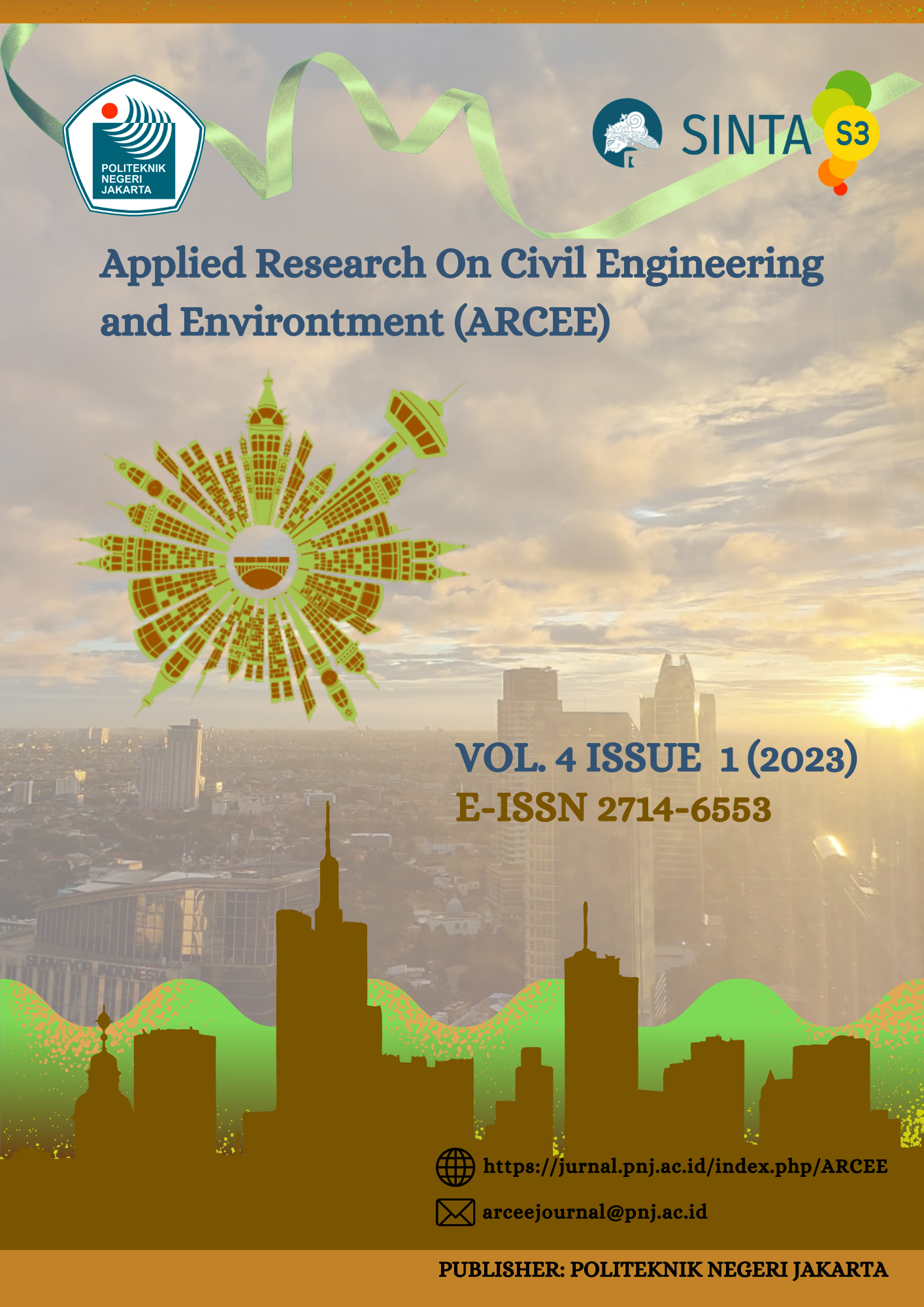Estimation Of Disharge Coefficient On Weir Configuration Based On Flow Rate And Velocity
##plugins.themes.academic_pro.article.main##
Abstract
The development of water treatment and water resources considers the flow rate adjusted using a weir. Weir is designed with many hydraulic factors, including the coefficient of discharge (Cd). Characteristics of the value of Cd show a decreasing trend on triangular and rectangular weirs. The value of Cd varies based on the flow's characteristics and the channel's geometry. Estimation of the best Cd value in flow discharge engineering and sediment deposition is necessary to know the accuracy of weir geometry. Some plans in water treatment and water resource building sometimes assume a Cd value based on literature. This study aims to estimate the value of Cd based on variations in flow rate and was conducted on a laboratory scale with weir shape limitations in the form of triangles and rectangles. The water sample was discharged by a water pump into an open channel. The angle of the weir opening was determined for the rectangular and triangular weir of 90°. Flow monitoring included flow discharge through the use of a current meter. Water was recycled in each measurement with a total of 60 cycles. The Cd values in a triangular weir were greater than in a rectangular weir. The Cd values for the rectangular weir ranged from 0.068 to 0.089, while the Cd values for the triangular weir ranged from 0.557 to 0.598. This value indicated that the greater the flow rate, the lower the Cd value. Therefore, weir configuration of water discharged using a triangular weir was better than a rectangular weir at low flow rates, less than 0.05 m3/s.
##plugins.themes.academic_pro.article.details##

This work is licensed under a Creative Commons Attribution-ShareAlike 4.0 International License.
References
- Akhbari, A., Zaji, A. H., Azimi, H., & Vafaeifard, M. (2017). Predicting The Discharge Coefficient of Triangular Plan From Weirs Using Radian Basis Function and M5 Methods. Journal of Appliend Research in Water and Washwater, 4(1), 281–289.
- Alwan, H. H., & Al-Mohammed, F. M. (2018). Discharge coefficient for rectangular notch using a dimensional analysis technique. IOP Conference Series: Materials Science and Engineering, 433(1). https://doi.org/10.1088/1757-899X/433/1/012015
- Alwan, Husam H., Saleh, L. A. M., Al-Mohammed, F. M., & Abdulredha, M. A. (2020). Experimental prediction of the discharge coefficients for rectangular weir with bottom orifices. Journal of Engineering Science and Technology, 15(5), 3265–3280.
- Ansari, M. A., Hussain, A., Shariq, A., & Alam, F. (2019). Experimental and Numerical Studies for Estimating Coefficient of Discharge of Side Compound Weir. Canadian Journal of Civil Engineering, 46(10), 887–895.
- Azamathulla, H. M., Haghiabi, A. H., & Parsaie, A. (2016). Prediction of side weir discharge coefficient by support vector machine technique. Water Science and Technology: Water Supply, 16(4), 1002–1016. https://doi.org/10.2166/ws.2016.014
- Badan Standardisasi Nasional. (2015). Pengukuran Debit pada Saluran Terbuka Menggunakan Bangunan Ukur Tipe Pelimpah Atas. In Jakarta : Badan Standardisasi Nasional (pp. 1–49). www.bsn.go.id
- Dabral, P. P., Pandey, P. K., Kumar, T., & Chakraborty, S. (2014). Determination of discharge coefficient and head-discharge relationships of different hydraulic structures. Journal of Indian Water Resources Society, 34(1), 40–52. http://www.iwrs.org.in/journal/jan2014/5jan.pdf
- Febrianto, J. W. (2018). Perbandingan Koefisien Debit dengan Lebar Saluran Berbeda Menggunakan Uji Fisik Peluap Persegi Panjang dan V-notch. Universitas Islam Indonesia.
- Ferro, V., & Aydin, I. (2019). Deducing The Stage-Discharge Relationship for Contracted Weirs by The Outflow Theory of Malcherek. Journal of Agricultural Engineering, 50(2).
- Hicks, A., & Slaton, W. (2014). Determining the Coefficient of Discharge for a Draining Container. The Physics Teacher, 52(1), 43–47. https://doi.org/10.1119/1.4849155
- Ionescu, C. S., Nistoran, D. E. G., Opriş, I., & Simionescu, S.-M. (2019). Sensitivity Analysis of Sharp-Crested Weirs as a Function of Shape Opening , for Small Discharges. Journal of Hidraulica, 2, 43–51.
- Irzooki, R. H., Akib, S. M., & Fayyadh, M. M. (2014). Experimental Study of Characteristics of Flow over Weirs with Semicircular Openings. Arabian Journal for Science and Engineering, 39(11), 7599–7608. https://doi.org/10.1007/s13369-014-1360-8
- Komarudin, K., Suprijatmono, D., & Pati, G. C. (2019). Pengujian Pengaruh Ketinggian Weir pada Koefisien Discharge dari Weirmeter Sharp-Crested V-Notch 90o. Bina Teknika, 15(1), 31. https://doi.org/10.54378/bt.v15i1.886
- Li, S., Yang, J., & Ansell, A. (2021). Discharge Prediction for Rectangular Sharp-Crested Weirs by Machine Learning Techniques. Flow Measurement and Instrumentation, 79, 101–931.
- Murthy, K. K. (1995). The theory of proportional weirs. Journal of the Indian Institute of Science, 75(4), 355.
- Namaee, M. R., & Shadpoorian, R. (2016). Numerical Modeling of Flow Over Two Side Weirs. Arabian Journal for Science and Engineering, 41(4), 1495–1510. https://doi.org/10.1007/s13369-015-1961-x
- Niazkar, M., & Afzali, S. H. (2018). Application of new hybrid method in developing a new semicircular-weir discharge model. Alexandria Engineering Journal, 57(3), 1741–1747. https://doi.org/10.1016/j.aej.2017.05.004
- Parsaie, A., & Haghiabi, A. H. (2015). The Effect of Predicting Discharge Coefficient by Neural Network on Increasing the Numerical Modeling Accuracy of Flow Over Side Weir. Water Resources Management, 29(4), 973–985. https://doi.org/10.1007/s11269-014-0827-4
- Sangsefidi, Y., Mehraein, M., & Ghodsian, M. (2015). Exprimental Investigation of the Hydraulic Performance of Arced Weirs. Journal of Civil Engineering, 15(2).

